Punjab State Board PSEB 9th Class Maths Book Solutions Chapter 12 Heron’s Formula Ex 12.2 Textbook Exercise Questions and Answers.
PSEB Solutions for Class 9 Maths Chapter 12 Heron’s Formula Ex 12.2
Question 1.
A park, in the shape of a quadrilateral ABCD has ∠C = 90°, AB = 9 m, BC = 12 m, CD = 5 m and AD = 8 m. How much area does it occupy?
Answer:
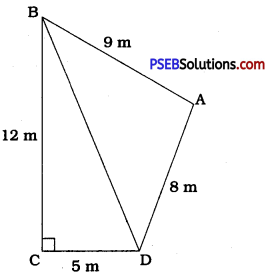
In ∆ BCD, ∠C = 90°
∴ BD2 = BC2 + CD2
= (12)2 + (5)2
= 144 + 25
= 169
= (13)2
∴ BD = 13 m
In ∆ BCD, a = 5 m, b = 12 m and c = 13 m
∴ Semiperimeter s = \(\frac{a+b+c}{2}\)
= \(\frac{5+12+13}{2}\) = \(\frac{30}{2}\) = 15 m
Then, s – a = 15 – 5 = 10m,
s – b = 15 – 12 = 3m and
s – c = 15 – 13 = 2 m.
Area of ∆ BCD = \(\sqrt{s(s-a)(s-b)(s-c)}\)
= \(\sqrt{15 \times 10 \times 3 \times 2}\) m2
= \(\sqrt{900}\) m2
= 30 m2
Note: ∆ BCD is a right triangle.
∴ Area of ∆ BCD = \(\frac{1}{2}\) × BC × CD
= \(\frac{1}{2}\) × 12 × 5 = 30 m2
Now, in ∆ ABD, a = 9 m, b = 13 m arid c = 8 m
∴ Semiperimeter s = \(\frac{a+b+c}{2}\)
= \(\frac{9+13+8}{2}\) = \(\frac{30}{2}\) = 15 m
Then,
s – a = 15 – 9 = 6m,
s – b = 15 – 13 = 2m and
s – c = 15 – 8 = 7 m.
Area of ∆ ABD = \(\sqrt{s(s-a)(s-b)(s-c)}\)
= \(\sqrt{15 \times 6 \times 2 \times 7}\) m2
= \(\sqrt{5 \times 3 \times 3 \times 2 \times 2 \times 7}\) m2
= 6 √35 m2
= 35.5 m2 (approx.)
Then, the area of park in the shape of quadrilateral ABCD
= Area of ∆ BCD + Area of ∆ ABD
= (30 + 35.5) m2 (approx.)
= 65.5 m2 (approx.)
Thus, the area of the park is 65.5 m2 (approx.)
![]()
Question 2.
Find the area of a quadrilateral ABCD in which AB = 3 cm, BC = 4 cm, CD = 4 cm, DA = 5 cm and AC = 5 cm.
Answer:
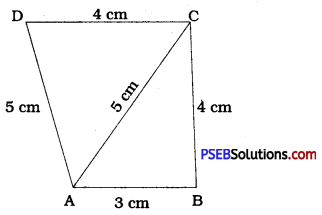
In ∆ ABC, a = 3 cm; b = 4 cm and c = 5 cm
∴ Semiperimeter s = \(\frac{a+b+c}{2}\)
= \(\frac{3+4+5}{2}\)
= \(\frac{12}{2}\) = 6 cm
Then,
s – a = 6 – 3 = 3 cm,
s – b = 6 – 4 = 2 cm and,
s – c = 6 – 5 = 1 cm.
Area of ∆ ABC = \(\sqrt{s(s-a)(s-b)(s-c)}\)
= \(\sqrt{6 \times 3 \times 2 \times 1}\) cm2
= 6 cm2
Note: Proving that ∆ ABC is a right triangle, Area of ∆ ABC = \(\frac{1}{2}\) × 3 × 4 = 6 cm2 can be obtained easily.
In ∆ ACD, a = 4 cm; b = 5 cm and c = 5 cm
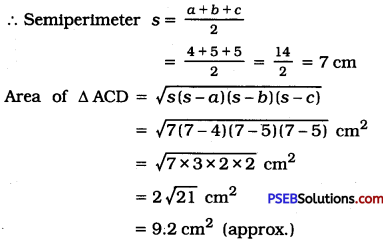
Area of quadrilateral ABCD
= Area of ∆ ABC + Area of ∆ ACD
= (6 + 9.2) cm2 (approx.)
= 15.2 cm2 (approx.)
![]()
Question 3.
Radha made a picture of an aeroplane with coloured paper as shown in the given figure, s Find the total area of the paper used. ;
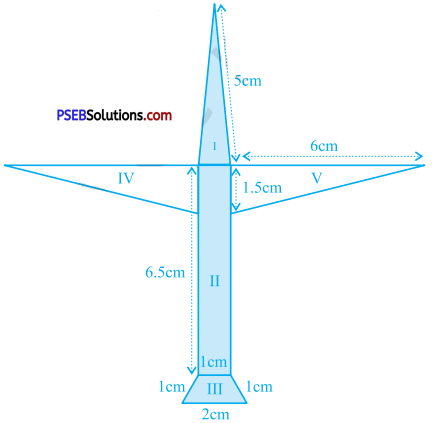
Answer:
The sides of the triangle in part 1 measure 5 cm, 5 cm and 1 cm.
∴ a = 5 cm, b = 5 cm and c = 1 cm
∴ Semiperimeter s = \(\frac{a+b+c}{2}\)
= \(\frac{5+5+1}{2}\) = \(\frac{11}{2}\) cm
Area of part 1
= Area of triangle
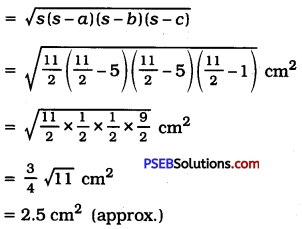
The length and breadth of rectangle in part II are 6.5 cm and 1 cm respectively.
Area of part II = Area of rectangle
= length × breadth
= (6.5 × 1) cm2
= 6.5 cm2
For the trapezium in part III, the parallel sides measure 1 cm and 2 cm, while both the non-parallel sides measure 1 cm each.
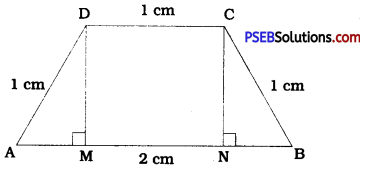
Drawing DM ⊥ AB and CN ⊥ AB. we get
AM = BM = \(\frac{2-1}{2}\) = \(\frac{1}{2}\) cm.
In ∆ DMA, ∠M = 90°
Area of trapezium ABCD
= \(\frac{1}{2}\) × Sum of parallel sides X Distance between parallel sides
= \(\frac{1}{2}\) × (AB + CD) × DM
= \(\frac{1}{2}\) × (2 + 1) × \(\frac{\sqrt{3}}{2}\)cm2
= \(\frac{1}{2}\) × 3 × \(\frac{\sqrt{3}}{2}\) cm2
= 1.3 cm2 (approx.)
For the right triangle in part IV the sides forming the right angle measure 6 cm and 1.5 cm.
Area of right triangle in part IV.
= \(\frac{1}{2}\) × Product of sides forming the right angle
= \(\frac{1}{2}\) × 6 × 1.5 cm2
= 4.5 cm2
The right triangle in part V is congruent to the right triangle in part IV.
∴ Area of right triangle in part V = 4.5 cm2
Now, total area of the paper used
= Areas of figures in part I to part V
= (2.5 + 6.5 + 1.3 + 4.5 + 4.5) cm2
= 19.3 cm2
![]()
Question 4.
A triangle and a parallelogram have the same base and the same area. If the sides of the triangle are 26 cm, 28 cm and 30 cm, and the parallelogram stands on the base 28 cm, find the height of the parallelogram.
Answer:
In the given triangle, a = 26 cm, b = 28 cm and c = 30 cm
∴ Semiperimeter s = \(\frac{a+b+c}{2}\)
= \(\frac{26+28+30}{2}\) = \(\frac{84}{2}\) = 42 cm
Area of triangle
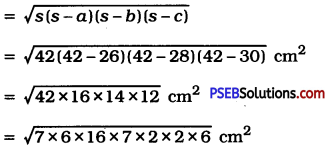
= 7 × 6 × 4 × 2 cm2
= 336 cm2
The area of the triangle and the area of the parallelogram are equal.
∴ Area of the parallelogram = 336 cm2
∴ Base × Corresponding altitude = 336 cm2
∴ 28 cm × Corresponding altitude = 336 cm2
∴ Corresponding altitude = \(\frac{336}{28}\) cm
∴ Corresponding altitude = 12 cm
Thus, the height of the parallelogram is 12 cm.
Question 5.
A rhombus shaped field has green grass for 18 cows to graze. If each side of the rhombus is 30 m and its longer diagonal is 48 m, how much area of grass field will each cow be getting?
Answer:

Rhombus ABCD in the given figure represents the field.
A diagonal of a rhombus divides it into two congruent triangles.
∴ Area of rhombus ABCD = 2 × Area of ∆ ABC
In ∆ ABC, a = 30 m; b = 30 m; and c = 48 m.
∴ Semiperimeter s = \(\frac{a+b+c}{2}\)
= \(\frac{30+30+48}{2}\) = \(\frac{108}{2}\) = 54 cm
Area of ∆ ABC

= 3 × 6 × 24 m2
= 432 m2
Now, area of the field
= area of rhombus ABCD
= 2 × area of ∆ ABC
= 2 × 432 m2
= 864 m2
Now, area of grass field available for 18 cows to graze = 864 m2
∴ Area of grass field available for 1 cow to graze = \(\frac{864}{18}\) m2 = 48 m2
Thus, each cow gets 48 m2 of grass field to graze.
![]()
Question 6.
An umbrella is made by stitching 10 triangular pieces of cloth of two different colours (see the given figure), each piece measuring 20 cm, 50 cm and 50 cm. How much cloth of each colour is required for the umbrella?

Answer:
Out of 10 triangular pieces, 5 are dark coloured and 5 are light coloured.
For each triangle, a = 20 cm, b = 50 cm and c = 50 cm

Hence, the total area of 5 dark coloured cloth pieces = 5 × 200 √6 cm2 = 1000 √6 cm2
Similarly, the total area of 5 light coloured cloth pieces = 5 × 200 √6 cm2 = 1000 √6 cm2
![]()
Question 7.
A kite in the shape of a square with a diagonal 32 cm and an isosceles triangle of base 8 cm and sides 6 cm each is to be made of three different shades as shown in the given figure. How much paper of each shade has been used in it?
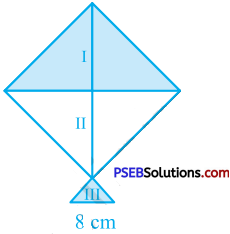
Answer:
Let us name the square part as ABCD and the triangular part as CMN.
Suppose the length of square ABCD is xcm.
∴ In ∆ ABD, AB = AD = x cm and ∠A = 90°
The length of hypotenuse BD is given to be 32 cm.
AB2 + AD2 = BD2 (Pythagoras’ theorem)
∴ (x)2 + (x)2 = (32)2
∴ 2x2 = 1024
∴ x2 = 512
∴ x = √512
∴ x = \(\sqrt{256 \times 2}\)
∴ x = 16√2
Thus, the length of each side of square ABCD is 16 √2 cm.
Area of part I = Area of ∆ ABD
= \(\frac{1}{2}\) × AB × AD (∠A is a right angle.)
= \(\frac{1}{2}\) × 16 √2 × 16 √2 cm2
= 256 cm2
Area of part II = Area of A BCD
= \(\frac{1}{2}\) × BD × CD (∠A is a right angle.)
= \(\frac{1}{2}\) × 16 √2 × 16 √2 cm2
= 256 cm2
Note: Here, area of square ABCD can easily be found as below:
Area of square ABCD = \(\frac{(\text { Hypotenuse })^{2}}{2}\)
= \(\frac{(32)^{2}}{2}\)
= \(\frac{1024}{2}\)
= 512 cm2
To find the area of part III, we find the area of ∆ CMN.
In ∆ CMN, a = 6 cm, b = 8 cm and c = 6 cm.
∴ Semiperimeter s = \(\frac{a+b+c}{2}\)
= \(\frac{6+8+6}{2}\) = \(\frac{20}{2}\) = 10 cm
Area of part III
= Area of ∆ CMN
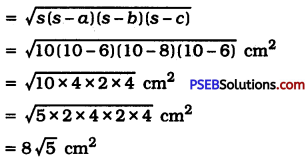
= 8 × 2.24 cm2 (approx.)
= 17.92 cm2 (approx.)
![]()
Question 8.
A floral design on a floor is made up of 16 tiles which are triangular, the sides of the triangle being 9 cm, 28 cm and 35 cm (see the given figure). Find the cost of polishing the tiles at the rate of 50 p per cm2.
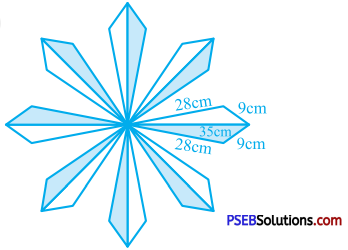
Answer:
For each of 16 triangular tiles,
a = 9 cm; b = 28 cm and c = 35 cm
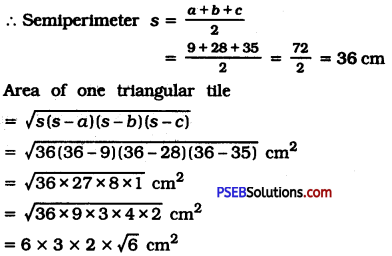
= 88.2 cm2 (approx.)
∴ Area of 16 tiles = 16 × 88.2 cm2
= 1411.2 cm2
50 paise = ₹ 0.50
Cost of polishing 1 cm2 region = ₹ 0.50
∴ Cost of polishing 1411.2 cm2 region
= ₹ (1411.2 × 0.50)
= ₹ 705.60
![]()
Question 9.
A field is in the shape of a trapezium whose parallel sides are 25 m and 10 m. The non-parallel sides are 14 m and 13 m. Find the area of the field.
Answer:
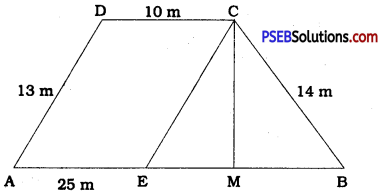
In the given figure, trapezium ABCD represents the field in which AB || CD,
AB = 25 m, BC = 14 m, CD = 10 m and DA = 13 m.
Through C, draw a line parallel to DA to intersect AB at E.
In quadrilateral AECD, AE || CD and DA || CE
∴ AECD is a parallelogram.
∴ CE = DA = 13 m and AE = CD = 10 m
Now, BE = AB – AE = 25 – 10 = 15 m
In ∆ CEB, a = 13 m; b = 15 m and c = 14 m
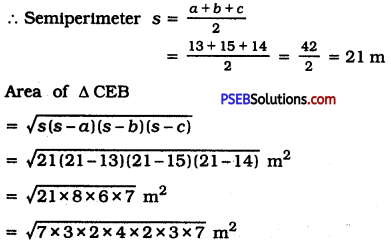
In ∆ CEB, draw CM ⊥ BE.
Area of ∆ CEB = \(\frac{1}{2}\) × BE × CM
∴ 84 m2 = \(\frac{1}{2}\) × 15 m × CM
∴ CM = \(\frac{84 \times 2}{15}\) m
∴ CM = 11.2 m
Area of parallelogram AECD
= Base × Corresponding altitude
= AE × CM
= 10 × 11.2 m2
= 112 m2
Hence, area of the field
= Area of trapezium ABCD
= Area of ∆ CEB + Area of parallelogram AECD
= 84 m2 + 112 m2
= 196 m2
Note: After finding CM = 11.2m, the area of . the field can also be found as below:
Area of the field
= Area of trapezium ABCD
= \(\frac{1}{2}\) × sum of parallel sides × distance between parallel sides
= \(\frac{1}{2}\) × (AB + CD) × CM
= \(\frac{1}{2}\) × (25 + 10) × 11.2 m2
= \(\frac{1}{2}\) × 35 × 11.2 m2
= 196 m2
